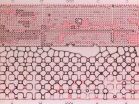(Press-News.org) MONTREAL, August 12, 2014 – An analysis of autism research covering genetics, brain imaging, and cognition led by Laurent Mottron of the University of Montreal has overhauled our understanding of why autism potentially occurs, develops and results in a diversity of symptoms. The team of senior academics involved in the project calls it the "Trigger-Threshold-Target'' model. Brain plasticity refers to the brain's ability to respond and remodel itself, and this model is based on the idea that autism is a genetically induced plastic reaction. The trigger is multiple brain plasticity-enhancing genetic mutations that may or may not combine with a lowered genetic threshold for brain plasticity to produce either intellectual disability alone, autism, or autism without intellectual disability. The model confirms that the autistic brain develops with enhanced processing of certain types of information, which results in the brain searching for materials that possess the qualities it prefers and neglecting materials that don't. "One of the consequences of our new model will be to focus early childhood intervention on developing the particular strengths of the child's brain, rather than exclusively trying to correct missing behaviors, a practice that may be a waste of a once in a lifetime opportunity," Mottron said.
Mottron and his colleagues developed the model by examining the effect of mutations involved in autism together with the brain activity of autistic people as they undertake perceptual tasks. "Geneticists, using animals implanted with the mutations involved in autism, have found that most of them enhance synaptic plasticity – the capacity of brain cells to create connections when new information is encountered. In parallel, our group and others have established that autism represents an altered balance between the processing of social and non-social information, i.e. the interest, performance and brain activity, in favor of non-social information," Mottron explained. "The Trigger-Threshold-Target model builds a bridge between these two series of facts, using the neuro cognitive effects of sensory deprivation to resolve the missing link between them."
The various superiorities that subgroups of autistic people present in perception or in language indicates that an autistic infant's brain adapts to the information it is given in a strikingly similar way to sensory-deprived people. A blind infant's brain compensate the lack of visual input by developing enhanced auditory processing abilities for example, and a deaf infant readapts to process visual inputs in a more refined fashion. Similarly, cognitive and brain imaging studies of autistic people work reveal enhanced activity, connectivity and structural modifications in the perceptive areas of the brain. Differences in the domain of information "targeted'' by these plastic processes are associated with the particular pattern of strengths and weaknesses of each autistic individual. "Speech and social impairment in some autistic toddlers may not be the result of a primary brain dysfunction of the mechanisms related to these abilities, but the result of their early neglect," Mottron said. "Our model suggests that the autistic superior perceptual processing compete with speech learning because neural resources are oriented towards the perceptual dimensions of language, neglecting its linguistic dimensions. Alternatively, for other subgroups of autistic people, known as Asperger, it's speech that's overdeveloped. In both cases, the overdeveloped function outcompetes social cognition for brain resources, resulting in a late development of social skills."
The model provides insight into the presence or absence of intellectual disability, which when causative mutation alter the function of brain cell networking. Rather than simply triggering a normal but enhanced plastic reaction, these mutations cause neurons to connect in a way that does not exist in non-autistic people. When brain cell networking functions normally, only the allocation of brain resources is changed.
As is the case with all children, environment and stimulation have an effect on the development and organization of an autistic child's brain. "Most early intervention programs adopt a restorative approach by working on aspects like social interest. However this focus may monopolize resources in favor of material that the child process with more difficulties, Mottron said. "We believe that early intervention for autistic children should take inspiration from the experience of congenitally deaf children, whose early exposure to sign language has a hugely positive effect on their language abilities. Interventions should therefore focus on identifying and harnessing the autistic child's strengths, like written language." By indicating that autistic ''restricted interests'' result from cerebral plasticity, this model suggest that they have an adaptive value and should therefore be the focus of intervention strategies for autism.
INFORMATION:
About This Study
Dr. Laurent Mottron, M.D., Ph.D., and colleagues Sylvie Belleville, Ph.D., Dr. Guy Rouleau, MD. Ph.D, and Olivier Collignon, Ph.D, published the article "Linking Neocortical, Cognitive and Genetic Variability in Autism with Alterations of Brain Plasticity: the Trigger-Threshold-Target Model" in Neuroscience and Biobehavioural Reviews on August 12, 2014. Laurent Mottron is a cognitive neuroscientist of autism and is affiliated with the University of Montreal Center of Excellence for Pervasive Developemental Disorders (CETEDUM), the IUSMM Research Centre Autism Programme at the university's affiliated Rivière-des-Prairies Hospital, and a professor at the university's Department of Psychiatry. IUSMM stands for Institut universitaire en santé mentale de Montréal. Sylvie Belleville is a cognitive and brain imaging neuroscientist and Scientific Director of the IUGM Research Center (Institut universitaire de gériatrie de Montréal, University of Montreal) and professor at the University of Montreal's Department of Psychology. Guy Rouleau is a neurologist and a geneticist, and he is Scientific Director of the Montreal Neurological Institute (MNI, McGill University). Olivier Collignon is the leader of a research group working on brain plasticity in sensory deprivation at the center for mind/brain science (CIMeC) and a professor at Trento University (Italy.) The University of Montreal is known officially as Université de Montréal.
This study was financed by the Canadian Institutes of Health Research.
Overhaul of our understanding of why autism potentially occurs
Researchers suggest the genetically-controlled mechanisms of plastic brain reorganization that potentially determine autistic capabilities and subtypes
2014-08-12
ELSE PRESS RELEASES FROM THIS DATE:
Foam favorable for oil extraction
2014-08-12
HOUSTON – (Aug. 12, 2014) – A Rice University laboratory has provided proof that foam may be the right stuff to maximize enhanced oil recovery (EOR).
In tests, foam pumped into an experimental rig that mimicked the flow paths deep underground proved better at removing oil from formations with low permeability than common techniques involving water, gas, surfactants or combinations of the three.
The open-access paper led by Rice scientists Sibani Lisa Biswal and George Hirasaki was published online today by the Royal Society of Chemistry journal Lab on a Chip.
Oil ...
Decline in daily functioning related to decreased brain activity in Alzheimer's
2014-08-12
Boston, MA – Decline in daily functioning associated with Alzheimer's disease is related to alterations in activity in certain regions of the brain, according to a study published in the August 2014 issue of the Journal of Alzheimer's Disease.
Impairment in instrumental activities of daily living—or an inability to perform high-level daily activities such as calculating finances, remembering appointments and medications, and driving—is first seen when a person has mild cognitive impairment, which can later progress to dementia due to Alzheimer's disease. Deterioration ...
Immigrants at lower risk of overdose, death from codeine than people born in Canada
2014-08-12
TORONTO, Aug. 12, 2014—Immigrants are at lower risk of an overdose or death after being prescribed codeine than people born in Canada, a new study has found.
Surprisingly, this is true even when the immigrants lack proficiency in English or French, which might be thought to hamper their ability to read prescription labels or instructions, said lead author Dr. Joel Ray, a physician and researcher at St. Michael's Hospital.
His study was published in the current issue of the Journal of Epidemiology and Community Health.
Dr. Ray undertook this study because of the large ...
Beating childhood cancer does not make survivors healthier adults
2014-08-12
Having survived cancer as a child does not necessarily have a ripple effect that makes people lead a healthier lifestyle once they grow up. In fact, in a report derived from a National Cancer Institute-funded study of childhood cancer survivors known as the Chicago Healthy Living Study, investigators found that childhood cancer survivors in no way adhere more closely to guidelines on healthy eating than their cancer-free peers. The findings are published in Springer's Journal of Cancer Survivorship.
Childhood cancer survivors face different health-care challenges and ...
Contrary to popular belief, more exercise is not always better
2014-08-12
Rochester, MN, August 12, 2014 – There is strong epidemiological evidence of the importance of regular physical activity, such as brisk walking and jogging, in the management and rehabilitation of cardiovascular disease and in lowering the risk of death from other diseases such as hypertension, stroke, and type 2 diabetes. The Physical Activity Guidelines for Americans recommends about 150 minutes per week of moderate-intensity exercise or about 75 minutes of vigorous-intensity exercise. But there is clear evidence of an increase in cardiovascular deaths in heart attack ...
Climate relicts may help researchers understand climate change
2014-08-12
While hiking through the Ozarks' characteristic oak and hickory forests as a teenager, ecologist Scott Woolbright discovered something decidedly uncharacteristic for the region: prickly pear cacti growing on an exposed, rocky ledge.
In a recent paper published in Trends in Ecology and Evolution, Woolbright describes how populations and communities like these, known as climate relicts, can help scientists understand how ecological communities are affected by climate change.
Rocky, well-drained slopes in the Ozarks often create habitat "islands" within the surrounding ...
NASA sees the end of Tropical Depression Genevieve
2014-08-12
Cloud tops were warming and precipitation was waning in Tropical Depression Genevieve when NASA's Aqua satellite flew overhead. Genevieve moved through all three Pacific Ocean regions (eastern, central and western) in its two week lifetime and met its end today.
NASA's Aqua satellite passed over Tropical Depression Genevieve on Aug. 11 at 01:29 UTC and the Atmospheric Infrared Sounder (AIRS) captured infrared data on the storm. AIRS data showed a small area of the strongest thunderstorms were occurring over the northern quadrant, where temperatures approached -63F/-52C. ...
Roadside research from the pinelands and coast to coast
2014-08-12
PHILADELPHIA (August 12, 2014)— "Roads are essentially the primary feature of human civilization at this point," according to Dane Ward, a doctoral student in environmental science at Drexel University who is presenting research at the Ecological Society of America (ESA) meeting.
Perhaps not surprisingly, Ward, along with fellow doctoral students Ryan Rebozo and Kevin P.W. Smith from the Laboratory of Pinelands Research led by Walter Bien, PhD in Drexel's College of Arts and Sciences, took advantage of a cross-country roadtrip from Philadelphia to the meeting in Sacramento ...
UMN and NYBC research finds potential MERS transmission mechanism between bats and humans
2014-08-12
Researchers have identified the mechanism used by the deadly MERS virus to transmit from bats to humans. Bats are a native reservoir for MERS and the finding could be critical for understanding the animal origins of the virus, as well as preventing and controlling the spread of MERS and related viruses in humans.
The findings were published in the most recent edition of the Proceedings of the National Academy of Sciences.
Leading the research was Fang Li, Ph.D., associate professor of Pharmacology at the University of Minnesota Medical School. Graduate students Yang ...
Notre Dame paper offers insights into a new class of semiconducting materials
2014-08-12
A new paper by University of Notre Dame researchers describes their investigations of the fundamental optical properties of a new class of semiconducting materials known as organic-inorganic "hybrid" perovskites.
The research was conducted at the Notre Dame Radiation Laboratory by Joseph Manser, a doctoral student in chemical and biomolecular engineering, under the direction of Prashant Kamat, Rev. John A. Zahm Professor of Science. The findings appear in a paper in the August 10 edition of the journal Nature Photonics.
The term "perovskites" refers to the structural ...
LAST 30 PRESS RELEASES:
Securing AI systems against growing cybersecurity threats
Longest observation of an active solar region
Why nail-biting, procrastination and other self-sabotaging behaviors are rooted in survival instincts
Regional variations in mechanical properties of porcine leptomeninges
Artificial empathy in therapy and healthcare: advancements in interpersonal interaction technologies
Why some brains switch gears more efficiently than others
UVA’s Jundong Li wins ICDM’S 2025 Tao Li Award for data mining, machine learning
UVA’s low-power, high-performance computer power player Mircea Stan earns National Academy of Inventors fellowship
Not playing by the rules: USU researcher explores filamentous algae dynamics in rivers
Do our body clocks influence our risk of dementia?
Anthropologists offer new evidence of bipedalism in long-debated fossil discovery
Safer receipt paper from wood
Dosage-sensitive genes suggest no whole-genome duplications in ancestral angiosperm
First ancient human herpesvirus genomes document their deep history with humans
Why Some Bacteria Survive Antibiotics and How to Stop Them - New study reveals that bacteria can survive antibiotic treatment through two fundamentally different “shutdown modes”
UCLA study links scar healing to dangerous placenta condition
CHANGE-seq-BE finds off-target changes in the genome from base editors
The Journal of Nuclear Medicine Ahead-of-Print Tip Sheet: January 2, 2026
Delayed or absent first dose of measles, mumps, and rubella vaccination
Trends in US preterm birth rates by household income and race and ethnicity
Study identifies potential biomarker linked to progression and brain inflammation in multiple sclerosis
Many mothers in Norway do not show up for postnatal check-ups
Researchers want to find out why quick clay is so unstable
Superradiant spins show teamwork at the quantum scale
Cleveland Clinic Research links tumor bacteria to immunotherapy resistance in head and neck cancer
First Editorial of 2026: Resisting AI slop
Joint ground- and space-based observations reveal Saturn-mass rogue planet
Inheritable genetic variant offers protection against blood cancer risk and progression
Pigs settled Pacific islands alongside early human voyagers
A Coral reef’s daily pulse reshapes microbes in surrounding waters
[Press-News.org] Overhaul of our understanding of why autism potentially occursResearchers suggest the genetically-controlled mechanisms of plastic brain reorganization that potentially determine autistic capabilities and subtypes




